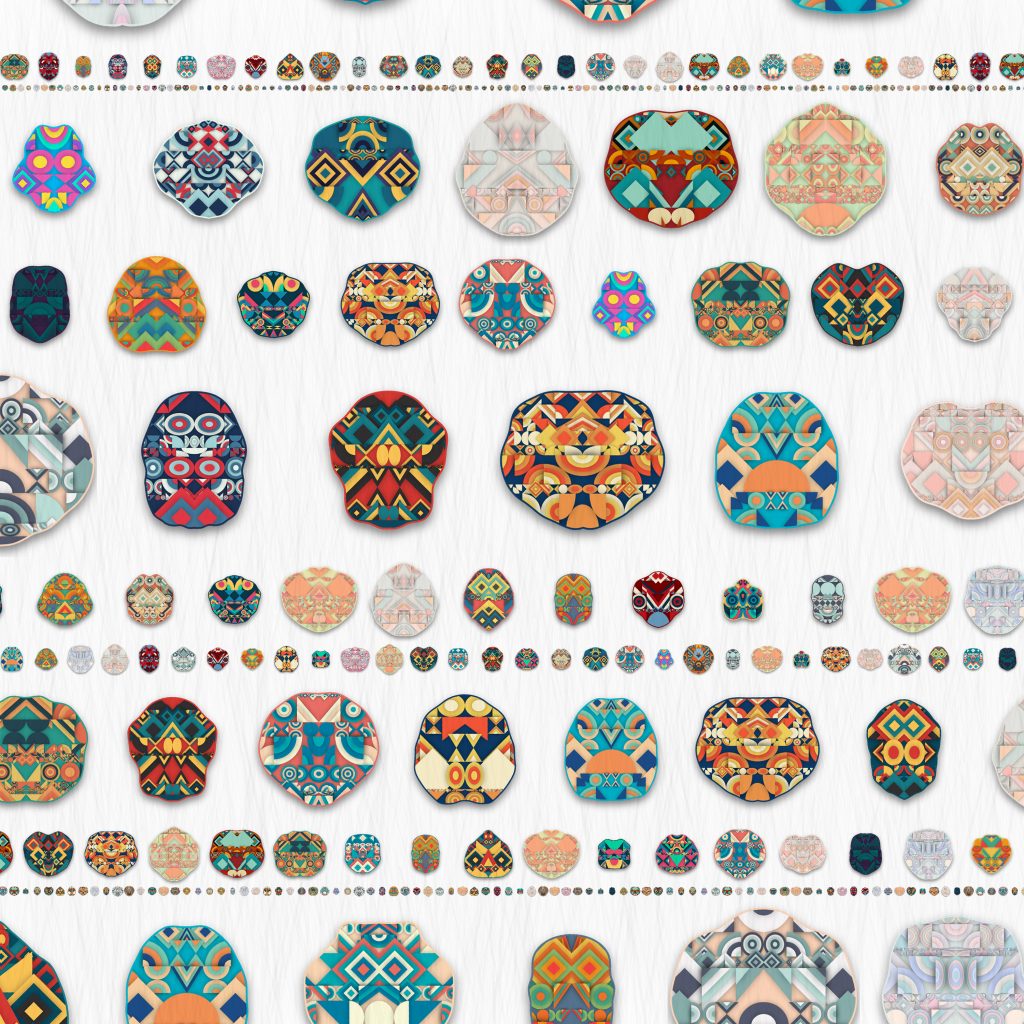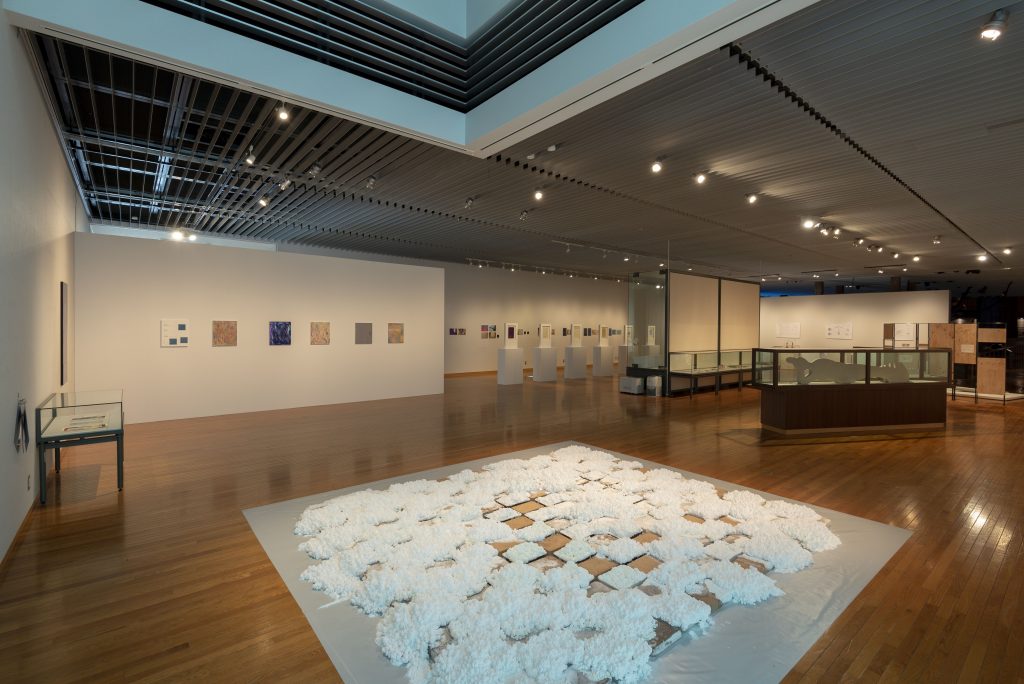This is the second part of ucnv’s interview with Mr. Takawo.
The NFT art scene is flooded with unknown characters, and this has led to some problems. Plagiarism is one of them. The second part of this article begins with a dialogue on this issue.
After this interview, Generativemasks was plagiarized again. At the same time, however, Generativemasks has expanded the community of owners. Infringement of or respect for the expression of others, and the nature of such human responses, must be an important issue for takawo, who repeatedly mentions and thinks about community in this interview.
As an interviewer, I did not think such things were very important until I conducted this interview. However, it is clear that NFT art creates not only artworks but also human networks around the artworks. This fact, glimpsed through the practice of Generativemasks, should provide us with a clue in considering the future of the act of expression.
Creative Coding and Licensing
ucnv I would also like to ask you about the plagiarism issue. A few months before the release of Generativemasks, you consulted with a creative coder whose work had been plagiarized. What did you think about the danger of such plagiarism when you decided to get into NFTs and what do you have to say about similar projects that have apparently emerged since Generativemasks, such as “Generative Fish?“[1].
takawo I was wondering what you thought about “Generative Fish.” It’s under the MIT license, isn’t it? I basically use the Creative Commons license, but I was wondering how to judge the appropriateness of the MIT license.
ucnv I think the author can’t complain about the plagiarism. Also, this is still a special case. Academic papers and texts have citation rules, and texts that don’t adhere to them are not worthy of trust. In the art world, there is an art form of plagiarism called appropriation, and uneducated plagiarism is subject to a great deal of criticism as not being in accordance with the history of art. Although there are licenses in the world of code, I think it is worth considering whether the current form of licensing for code matches the world of generative and creative coding.
takawo Do you think of it as software, or as a production that includes the graphics that correspond to the code? The interpretation varies depending on the situation. On the Creative Commons website, there is a statement in the FAQ section that “it is not appropriate to license software with a Creative Commons license.” I think it would be interesting to have a discussion with a legal expert or something.
ucnv However, the problem of plagiarism in NFT art is clearly caused by the lack of literacy and knowledge of the people who take the work. Or, it comes from a lack of respect and ignorance. In text, the text itself is valued, and in the art world, the value of the work is valued, but in the NFT art world, the code is not evaluated. And it’s also not sure if the visual representations are valued. It seems a very large weight of evaluation of whether a contract will be formed or whether it will be an investment. For those who trade according to such an evaluation axis, “who wrote what code” is not important. This is a problem for the market, and also for the community that creates the market.
takawo As for the fact that creative coders have been targeted for plagiarism, it can be seen as a sign that Japan is not connected to the international community or the creative coding scene. This leads me to the idea of the organization I want to establish.
I also feel that there is a lack of respect for art history and culture in the NFT art scene. Now that I’ve released NFT Art, I’ll continue to be involved in the scene, so I have a responsibility to change things and communicate what needs to be communicated.
ucnv Let me ask you something. For example, about 90% of the code was copied and pasted, and a completely different looking product was sold as an NFT. Would you be upset by something like that?
takawo I might not get angry.
ucnv If so, does your self-evaluation lie in the visual representation of the output?
takawo I wonder what I should say about… If I evaluate it by the amount of rewritten code or the “number of characters.” If we treat the code as a natural language, it is possible that the impression of the story will change just because one sentence is changed. The difference is between the “rewritten content” and the “changed graphics,” not the quantity, and it’s what determines whether the originality is recognized or not.
ucnv That’s right. On the other hand, there is a pattern where the code was written from scratch, but looks exactly the same.
takawo I think that would be a good contrast. For example, the “ReCode Project” restores and archives historical computer art works from the past, and rewrites them in a different environment, but I think we can recognize the originality in them (albeit via a volatile memory).
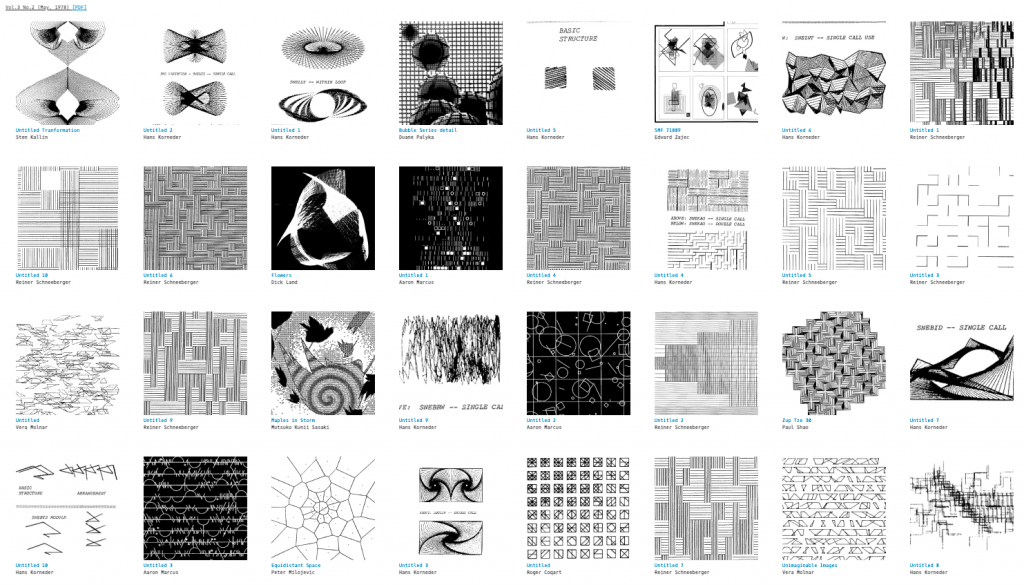
I’ve been feeling a bit sorry about the way Generativemasks has handled similar projects. Of course, this was their fault for not checking the license, but on the other hand, they have the skills to crack my code at a very fast pace. I wondered if I could have taken advantage of their skills to ask them to contribute in some way, or to collaborate with them, or in some other better way. If you could help us with the financial goal of this project, which is to donate the proceeds, I think we could have found a way to work together in some way.
ucnv Wasn’t that a complete copy and paste?
takawo The color palette was slightly rearranged, and the parameter values were slightly changed, but the basics were the same. I think only 5%, or maybe 1%, of the parameters were changed.
ucnv If I rewrote even 1%, would it violate the license?
takawo You’re right. There was no reference to my code. The same license was used to release the code or rather, to release what they had created with it, which was not protected.
ucnv If the license is displayed, can it be resold for commercial use?
takawo No, it’s non-commercial, so you can use it as long as you don’t use it for commercial purposes and give credit. We can also grant permission if the other party requests it. So, for example, if you want to develop Generativemasks’ goods commercially, we’d have you contact the team.
The NFT art scene lacks consideration and respect for art history.
ucnv In 1965, an artist named A. Michael Noll created a computer-generated work.
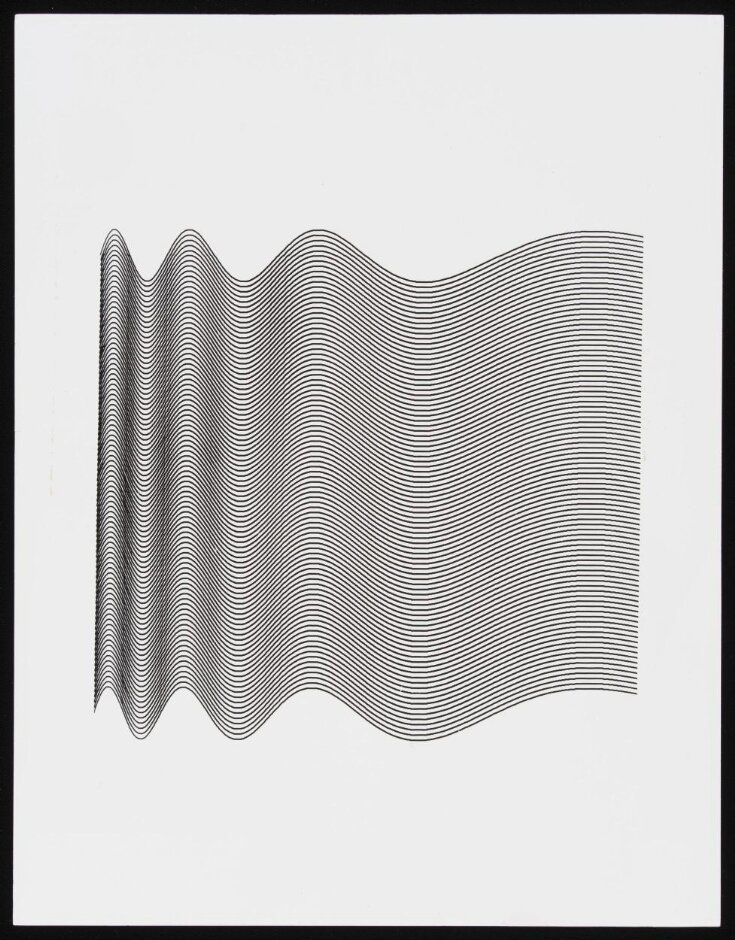
Michael Noll was one of the pioneers of computer graphics, who created computer-generated redrawings of Piet Mondrian’s works and also wrote papers as a researcher. Regarding this work using sine waves called “Ninety computer-generated sinusoids with linearly increasing period,” he referred to the series “Current” by the painter Bridget Riley and says something like, “This painting can be painted more reasonably using a computer.”
Bridget Riley’s painting was done in 1964, and Michael Noll’s was made in 1965. What I’m wondering is the insensitive way in which he made the computer-redrawn image of the painting by the artist of his own time. I don’t know what the two artists thought of each other at the time, or if they even interacted at all, but this kind of thing was happening in the early days of computer art. This kind of insensitivity to art production and art history, which is not based on the premise of appropriation as an art form, is now becoming apparent in NFT art.
Was this kind of thing allowed to happen because computer art is not mainstream in the art world? Or is it because we are doing these things that we are not mainstream? Anyway, one could feel that this “ignorance” exists in the people who participate in NFT art. In short, there may be a lack of knowledge and respect for the history of art.
takawo There is a lot of connection between what I just said and the current situation of NFT art. Talking about Michael Noll’s attitude, I wonder how much he thought of his own work as original.
ucnv In fact, this work is in the SIGGRAPH collection and I’ve had it in two exhibitions, so I’m sure they were aware that it was a work of art. It’s possible, though, that he thought that computer art and the mainstream art world were two completely different things.
takawo I suppose it is possible to innocently reference and sample each other’s work if both parties were working on new art in different scenes at this time. Incidentally, did this cause any kind of uproar or become the subject of debate?
ucnv I don’t think so.
takawo That’s right. I think he was aware of this problem, but I don’t think it reached Bridget Riley. The current NFT art world is also rampant in this way. The project itself is a reference to something else, or if it’s a character, it’s just a variation.
On the other hand, although I don’t recognize it in the context of art, in the world of games, for example, when derivatives are created from categories such as “roguelike games” or “hack and slash[2]“, they can help players understand the systems employed by the games. While I think the situation is different in this area, I overlook the fact that we are in a difficult time––wondering how to claim originality and legitimacy.
Not “it’s media art,” but “it’s a media art situation.”
ucnv By the way, I also wanted to ask this: What does this tweet mean by “media art”?
takawo The “unexpected” part is important, because as I’ve said, this project is not a one-off, it’s a continuous thing, and it’s also connected to the daily coding in my life.
But that wasn’t my intention in the beginning. I was just writing code every day and enjoying the finished product as a “dialogue between myself and the screen,” but it is now turning into a mysterious activity of trying to hack the advanced capitalist system called NFT. One person is getting involved in such a thing and being tossed around. It’s like watching a documentary.
ucnv I’m not sure what this term “media art” refers to. Does it mean that you become involved in something, like in a documentary situation?
takawo I think that media art refers to “works that use media technology, but do not treat it merely as a tool, but have an inherent critical perspective on the technology and the way it is received. The critical viewpoints on NFT art and market economy that I have been talking about so far were half of my project, but they really came into it. However, it would not have been possible if Generativemasks had not sold out, and my personal will and enthusiasm alone would not have led to this situation. So it’s really a situation where I’m doing media art by accident.
ucnv I’m sure there are many opinions on this, but my perception is that there is an “artist” in “art.” There is no way around the premise of “art” that some kind of author presents as a work of art. In that sense, I don’t think your situation is art yet.
takawo I agree with you. It’s not “media art.” I’ve already told you that this project is only valued within NFT, so I don’t know if it’s appropriate to call it a “work of art” yet. I don’t think I’ve expressed my own attitude enough to call it a work. In my mind, Generativemasks is not yet complete.
ucnv I feel that the heart of Generativemasks, as explained by takawo, lies in hacking NFT art. I think this kind of action is like media art. But on the other hand, I feel that the idea of daily coding, which connects daily life and code, is not connected with the hacking attitude. How do these two positions coexist in your mind, takawo?
takawo The hackers are the clever, tricksters, or value subversives, while the daily coding beings are the good, naive?
ucnv Something like that.
takawo It’s true that daily coding itself is an activity for people who don’t have a background in computer science and who don’t specialize in programming. But on the other hand, writing code is also an act of putting your hands between the computer and the display, isn’t it? I think that the hacking spirit and the improvisational simplicity of daily coding, like building a hut out of things you see, sometimes go hand in hand. The idea for this donation was also a reaction that came to me on the spot, so I think the two are not opposites.
Are you still skeptical about the current NFT world because you think that collectors are only buying works for speculative purposes?
ucnv Also, I think that the way NFT art is evaluated has too little respect for the trial and error of the art that has been built up over the years. It seems too expressionistic. What do they think of conceptual attempts, the immateriality of the work, or contemporary art attempts like social practice? In the current art, there is a strong trend in the direction of how to abandon visuality such as in painting, and in the NFT, only visual representations are being evaluated.
Speaking of myself as an artist, I’m not interested in visual representations. I don’t really care. Some glitch artists who have been active for a long time are also participating in NFTs, but I think, “You guys are like that after all. In the end, you guys just like bright and shiny things.” As of today, I don’t think I’m interested in a place where that kind of thing is valued. I’m not sure about tomorrow, though.
takawo I think that the things you mentioned will change as collections are launched with proper curation and the scene matures. For example, the online exhibition “Feral File” started by Casey Reese, a developer of Processing, which sells NFT art, has a curator and a statement. They are trying to create a platform for the presentation of art in cyberspace. Sensible activities are beginning to emerge. What we need is for these approaches to become more active and for a proper art scene to be formed.
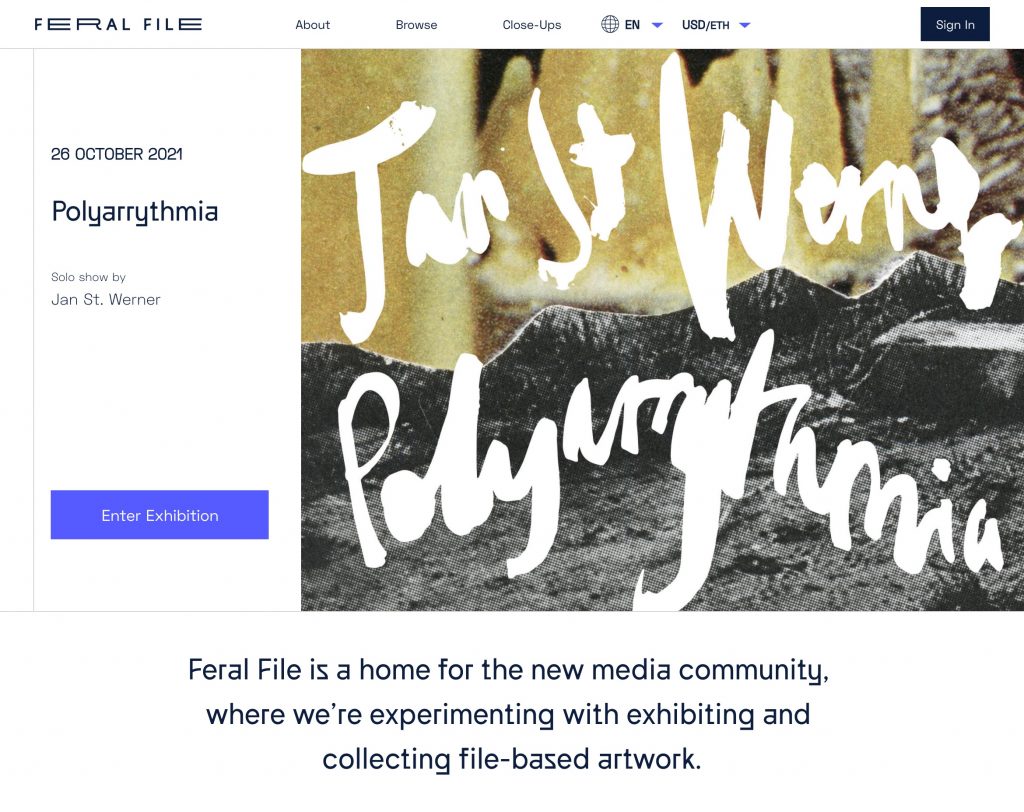
However, coming back to the topic, the main focus of my activities and where I ultimately come back to is how to continue daily coding in a healthy way for a long time. In that area, ucnv-san answered, “There’s a possibility that it won’t be directly connected to the community.” I didn’t understand that part. What do you mean by that?
ucnv There are many ways of understanding “contribution to the community,” but for example, there are people who are engaged in expressive activities without being involved in the management of the community. I didn’t understand how the sustained expression of such people is connected to the development of the community. Creative coding, to be frank, is making useless things, isn’t it?
takawo You put it very clearly (laughs).
ucnv Maybe there could be daily coding that has a function, but basically there are no functions. One possible way to “contribute to the community” is to commit to functional code, for example, to be a committer for the base code of OpenProcessing.org, or to create a base to support such creative coding.
takawo: Yeah.
ucnv I think that’s a more intuitive and easier to understand interpretation of “contribute to the community.” I was wondering if there was a direct connection between continuing to express oneself and contributing to the community.
takawo Simply put, because I can’t write useful code or code that is beneficial to others––maybe it’s because I’m involved in education, but I think what I can do is to increase the number of people who are interested in creative coding by saying, “This is fun,” “This is interesting,” and “Why don’t you guys try creative coding,” like Tom Sawyer painting a fence. From the people who are interested in it, I think there will come ideas for developing a library, creating a utility, or something like that.
Even though we call ourselves “the Japanese Processing community,” we are a very small group. If I were to plan online events by myself, I felt that the community would gradually become unbalanced. So in that sense, it’s very important to have more friends.
If I don’t get more people involved, whether it’s the Processing community or a corporation like the one I’m trying to build now, I’ll have to do more things on my own than if I don’t have a good library or more high-level code. It was born from this awareness of the problem.
ucnv I see. By the way, I recently made a major update to the library I’ve been working on for more than 10 years, and Generativemasks was the reason behind it.
takawo Why? (Generativemasks) doesn’t have that kind of power does it?
ucnv It made me feel like I have to write code too. I’d like to report that it had some impact on coders like me who are not involved in creative coding.
takawo I’m really happy about that. I think that’s what it’s all about. I want to create a spark that inspires something from my activities, and it would be great if someone could feel something. I mean, why didn’t you tell me that earlier? (laughs) If you’d told me a little earlier…
ucnv The temperature of the interview may have risen (laughs).
- [1]Generative Fish is an NFT art project that emerged shortly after Generativemasks. It generates unique fish drawings by code and sells them. The project is based almost directly on a program called fishdraw, developed and published by Lingdong Huang. At the time of the interview, Huang’s statement condemning the unauthorized use of the program attracted a lot of attention↩
- [2]Both “roguelike” and “hack-and-slash” refer to game genres. The former refers to an exploratory RPG in which the map is automatically generated each time you play, while the latter refers to a game in which the main objective is to keep defeating the enemies that appear. Both of these genres continue to spawn a variety of variants in the realm of computer games↩
